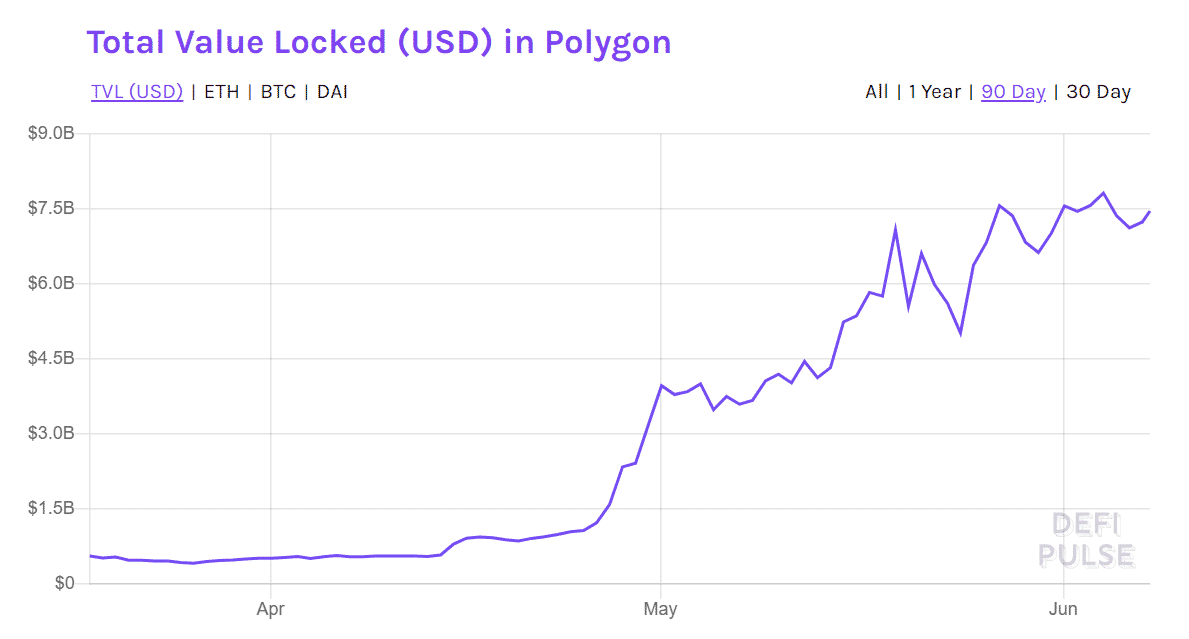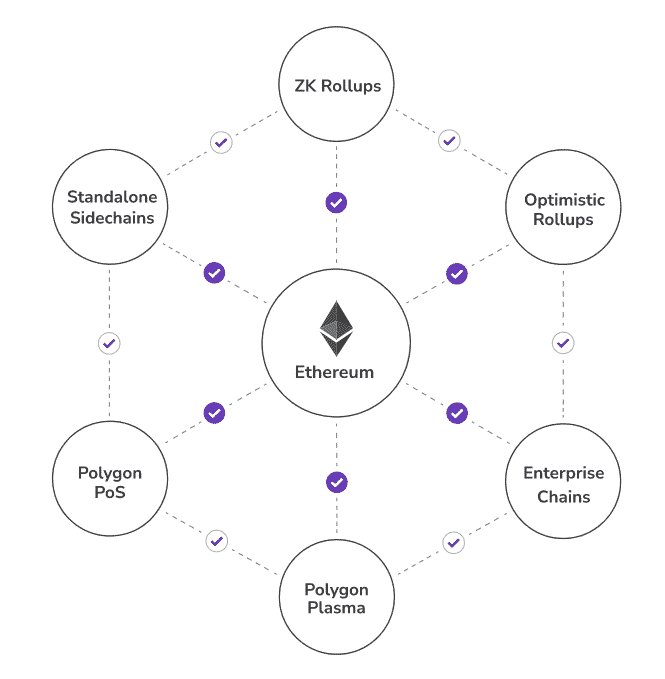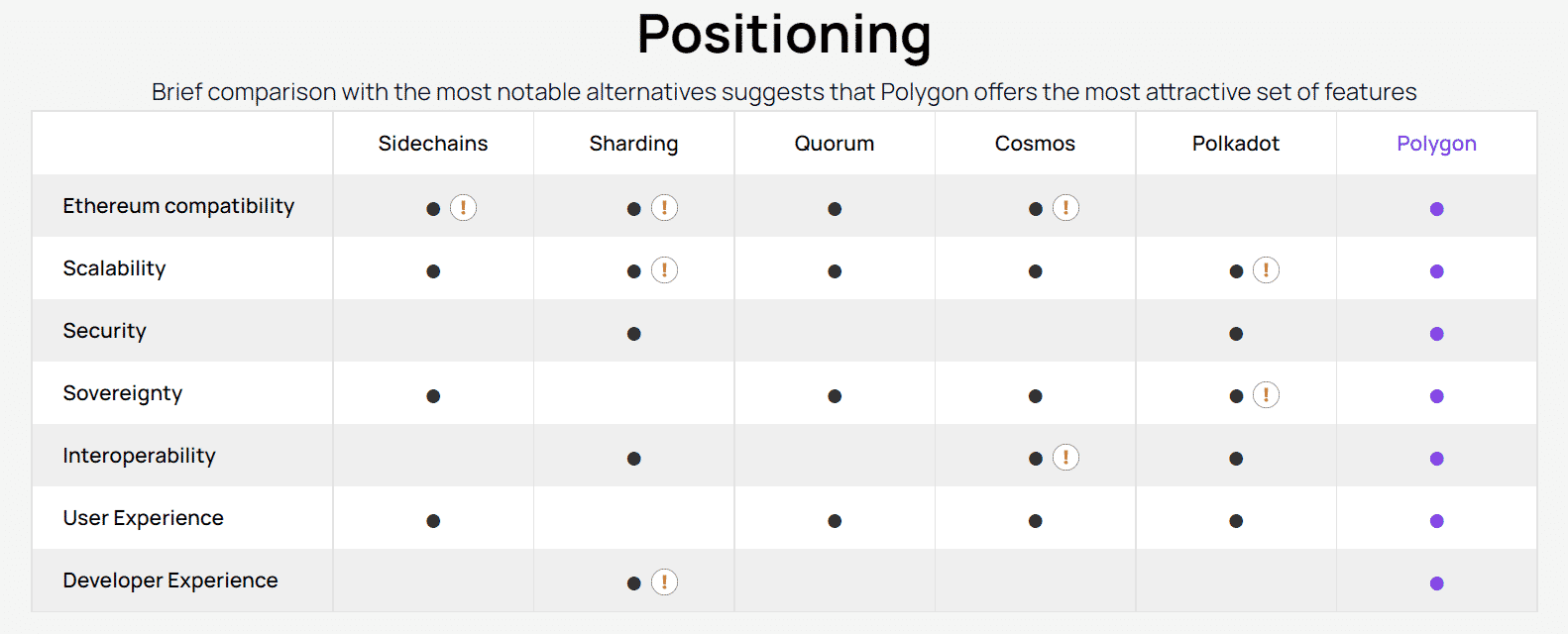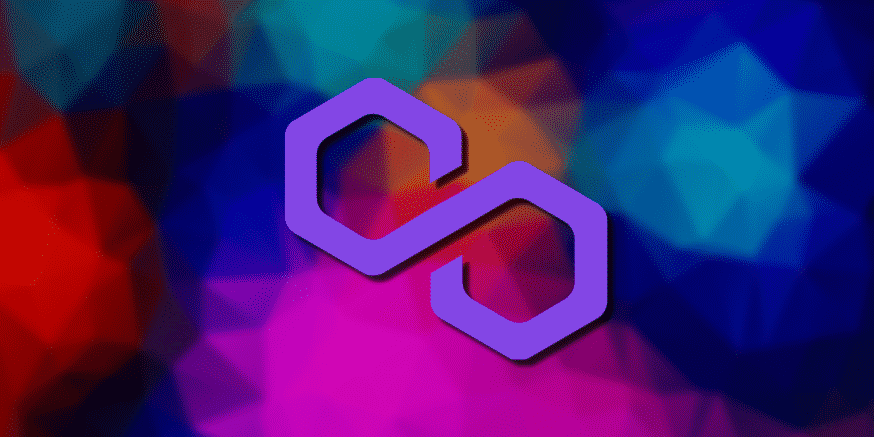Polygon (formerly known as Matic Network) is a layer two (L2) scaling solution for Ethereum-compatible blockchain networks that enables fast, inexpensive, and secure off-chain transactions for payments and general interactions with off-chain smart contracts.
Polygon was initially launched in 2017 under the name of Matic Network with the purpose of creating a protocol and a framework for building and connecting Ethereum-compatible blockchains using a variety of technical solutions.
Polygon’s current flagship product is the Matic PoS Chain, an EVM-compatible sidechain secured by a permissionless set of PoS validators with a theoretical throughput capacity of 65,000 transactions/second on a single Matic sidechain.

Polygon also built a modular and extensible framework for building Ethereum-compatible blockchain networks, written in Golang, called Polygon SDK, and is further working on two additional L2 scaling solutions, zk-Rollups and Optimistic rollups, based on zero-knowledge and fraud proofs respectively.
Who is Building Polygon?
The Polygon team has thirteen employees, with four technical co-founders, six additional developers, a product manager, and two marketing specialists. The core team is additionally supported by a community of reputable advisors, including Hudson Jameson from the Ethereum Foundation, Ryan Sean Adams from Bankless, Anthony Sassano from EthHub & SetProtocol, Pete Kim from Coinbase, and John Lilic – ex ConsenSys.

The core co-founding and development team consists of CEO Jaynti Kanani, COO Sandeep Nailwal, CPO Anurag Arjun, and VP of engineering Mihailo Bjelic.
Jaynti Kanani is a full-stack developer and blockchain engineer who’s previously contributed to many notable projects, including Web3, Plasma, and WalletConnect.
Sandeep Nailwal is a blockchain programmer, entrepreneur, and co-founder & CEO at ScopeWeaver, a firm that provides blockchain products and consulting services.
Anurag Arjun is a product/project manager who previously worked for AVP, IRIS Business, Cognizant Technologies, and SNL Financial.
Mihailo Bjelic joined the Matic team as a co-founder and VP of engineering only recently, when the project rebranded to Polygon. Before joining Polygon, Bjelic worked on similar blockchain scaling solutions as Matic.
What Problem is Polygon (MATIC) Solving?
Polygon is addressing Ethereum’s top limitations: scaling or transaction throughput and poor user experience.
Rather than offering limited scaling solutions like its predecessor Matic—which utilized a technology known as Plasma that allows for the creation of customizable ‘child’ blockchains to process transactions off-chain before finalizing them on the main Ethereum chain—Polygon is designed to be a comprehensive protocol and framework for launching interoperable blockchains.

Scaling is Ethereum’s oldest and most hindering problem. Ethereum’s current transaction throughput capabilities are grossly insufficient to satisfy the growing demands of the community. DeFi is blowing up fast, and with most of it being built on Ethereum, the protocol needs to scale yesterday because the current transaction costs are pricing out a vast majority of the users.
When it comes to scaling, blockchains can generally take two different paths:
- Scale the mainchain or the so-called layer one of the protocol, where projects are typically forced tо choose between different trade-offs and make certain sacrifices in either decentralization, scalability, or security (aka the blockchain trilemma)
- Or, use side chains that operate on top of the mainchain (layer two) to offload some of the work and hence ease the congestion on the main chain.
In this regard, Ethereum’s approach is to take both directions simultaneously — i.e., scale on layer one by implementing sharding and transitioning to a proof-of-stake consensus mechanism (Ethereum 2.0), and also use sidechain solutions like the one Polygon is building to scale even more and sooner.
Thanks to the Matic sidechain, the Ethereum network can scale significantly and do it effectively without making any sacrifices in terms of decentralization. Sidechains offer cheap and almost instantaneous transactions that are ultimately settled in batches on the mainchain, meaning that they leverage the robust security of the mainchain without making any compromises in terms of performance.
How Does Polygon (MATIC) Work?
Polygon’s so-called Matic Sidechain works like any other PoS-based blockchain, with its own infrastructure, token, user nodes, validator nodes, native dapps, and so on, except the transactions are ultimately batched and settled on the Ethereum mainchain (similar to how Bitcoin’s L2 scaling solution called Lightning Network works.)
You can think of the Matic sidechain as its own small interoperable ecosystem — part of the broader universe of Ethereum — offering users superior performance and user experience. Every decentralized application built on Ethereum or any other Ethereum-compatible blockchain can be ported to the Matic Sidechain and operate there in a much more performance-optimized environment.

Users who wish to interact with decentralized applications that have migrated to the Matic Sidechain need to:
- Approve the so-called Predicate Contract deployed on the Ethereum network, which locks the tokens to be deployed on the Matic Sidechain,
- Once the Predicate Contract has been approved; the next step is to deposit the tokens on the Matic Sidechain, which is done somewhat automatically. In this process, a particular smart contract called RootChainManager triggers another smart contract called ChildChainManager that mints the appropriate amount of locked or deposited ERC20/ERC721/ERC1155 tokens on the Matic network.
- Once the user receives their tokens on the Matic Sidechain, they can transfer them almost instantaneously and with negligible fees within the network. This means that trading or providing liquidity using a decentralized exchange such as SushiSwap on Matic will cost the user cents instead of $50-200, as is the case with using the same protocol on the Ethereum mainchain.
- Withdrawing the tokens back to Ethereum is a two-step process: first, the tokens have to be burnt on the Matic sidechain, and then the proof of this burn transaction has to be submitted to the Ethereum mainchain. Once this process is completed (takes about 20-30 mins), the RootChainManager smart contract will automatically deposit back assets to the user’s address (wallet) back on the Ethereum mainchain.
Polygon’s $MATIC Token?
The MATIC token (ticker: MATIC) serves a variety of purposes within the Polygon ecosystem, including paying for transaction fees (similar to how ETH tokens are used to pay for gas fees on the Ethereum mainchain), contributing to security through staking, and participating in the protocol’s decentralized governance by voting on Polygon Improvement Proposals (PIPs).
The current circulating supply of the MATIC token is 6.3 billion, while the total token supply (hard cap) is 10 billion. Users can also convert the MATIC token to other assets ported on the Matic Sidechain using different token swap or exchange protocols on the network.
Where Can You Buy Polygon’s $MATIC Token?
Polygon is available on popular cryptocurrency exchanges like Coinbase Pro, Binance, FTX, and Huobi Global.
Modest Overview of the Polygon Ecosystem
In general, the Polygon ecosystem consists of multiple actors, including users, developers, stakers, and block producers.
Polygon users can use the Matic Sidechain to transact and interact with various Ethereum-based decentralized applications, just like they would do on Ethereum or any other blockchain, except Matic is much cheaper and faster.
On the other hand, the developers are expected to use the Polygon Network and the Polygon SDK stack to build their own sidechains or scale their own dapps to provide their users with a superior user experience.

The stakers on Polygon effectively play the same role as PoW miners on Ethereum. They need to stake (lock) MATIC tokens to participate in validating and verifying transactions on the Matic Sidechain. Moreover, using their staked tokens as voting power, they can elect so-called block producers (stakers that satisfy specific criteria) to produce the blocks on the sidechain.
Block producers are chosen by the stakers to produce the blocks and ultimately settle all transactions on the network. They need to stake a significant sum of MATIC tokens in order to qualify and be elected.
Typically, the number of block producers will be relatively low because having fewer consensus creators allows for higher throughput and much faster transaction settlements. For example, the average block time on the Ethereum mainchain is ~20 seconds, while the Matic Sidechain mines or creates and settles a new block every second.
Final Thoughts: Will Polygon “Fix” Ethereum?
Perhaps the paramount aspect of Polygon’s value proposition is that it is one of the only layer-two scaling solutions built on Ethereum that has experienced moderate to mass adoption.
Polygon helps to significantly improve Ethereum’s transaction throughput and solve the high gas fee problem, but it also plays a crucial role in improving the broader problem of blockchain interoperability.






